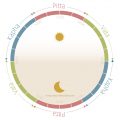The three fundamental regulatory principles of Ayurveda are called the Doshas. They are called Vata, Pitta and Kapha.
- Vata stands for movement and flow. It is responsible for all movement processes in the body, controls the nervous system, circulation, breathing, excretory processes and the activity of the mind.
- Pitta is the metabolic principle and regulates the activity of the digestive system, body temperature and metabolism. The intellect and emotional expression are also subject to the function of Pitta.
- Kapha is the structural principle. It forms the framework of matter and is responsible for the body’s fluid balance and natural defences.
These three Doshas interact at all levels of the organism. They create structures and generate functions, in each individual cell as well as in the entire body. The balanced functioning of Vata, Pitta and Kapha creates health. When this balance is lost, diseases arise.
The balance of the Doshas does not mean an exact equal distribution. Rather, everyone has an individual constellation of these three regulatory principles, which determine the basic constitution. Most people are characterised not only by one Dosha, but by two or even all three (Tridosha).
- A person who is predominantly Vata has a light, delicate physique with slight musculature, clearly visible tendons and veins, dry skin and sparse hair. Their appetite is variable and digestion rather irregular. They are agile, mentally active, have very quick perception and need little sleep.
- The Pitta type is of medium height with an athletic build. Their complexion is reddish, their skin well supplied with blood and slightly oily, they sweat quickly and tend early to greying of the hair as well as baldness. Appetite and digestion are strong. Pitta types are precise, intelligent, perfectionistic, and convincing speakers.
- Those who are dominated by Kapha have well-proportioned, solid frames with strong muscles and well-developed fatty tissue. They have full hair and tend to have oily skin. Metabolism and digestion are sluggish. They are relaxed, tolerant, have a healthy, long sleep, an excellent memory, strong stamina and are methodical in their way of working.
Every organism strives for its ideal Dosha constellation because it feels most at ease with it. This state is called Prakriti. Therefore, the guiding principle of Ayurvedic medicine is “Prakriti Sthapan: Live your nature”.
When our inner nature is distorted, when the Doshas are out of balance, this state is called Vikriti, or the disturbed function of Vata, Pitta and Kapha.
The purpose of Ayurvedic diagnosis, prevention and therapy is always to determine the current balance of the Doshas and to correct or maintain it – for a healthy, thriving lifestyle.






